DOWNLOADS
Architecture of Karnataka
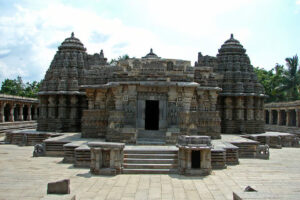 Karnataka is a state in the southern part of India originally known as the State of Mysore. Over the centuries, architectural monuments within the region displayed a diversity of influences, often relaying much about the artistic trends of the rulers of twelve different dynasties. Its architecture ranges dramatically from majestic monolith, such as the Gomateshwara, to Hindu and Jain places of worship, ruins of ancient cities, mausoleums and palaces of different architectural hue. Mysore Kingdom (Wodeyar) rule has also given an architectural master structure in the St. Philomena’s Church at Mysore (extolled by the King as a structure of divine compassion and the eager gratitude of men) which was completed in 1956, in addition to many Dravidian style architectural temples. Two of the monuments (Pattadakal and Hampi) are listed under the UNESCO World Heritage List of 22 cultural monuments in India.
Karnataka is a state in the southern part of India originally known as the State of Mysore. Over the centuries, architectural monuments within the region displayed a diversity of influences, often relaying much about the artistic trends of the rulers of twelve different dynasties. Its architecture ranges dramatically from majestic monolith, such as the Gomateshwara, to Hindu and Jain places of worship, ruins of ancient cities, mausoleums and palaces of different architectural hue. Mysore Kingdom (Wodeyar) rule has also given an architectural master structure in the St. Philomena’s Church at Mysore (extolled by the King as a structure of divine compassion and the eager gratitude of men) which was completed in 1956, in addition to many Dravidian style architectural temples. Two of the monuments (Pattadakal and Hampi) are listed under the UNESCO World Heritage List of 22 cultural monuments in India.
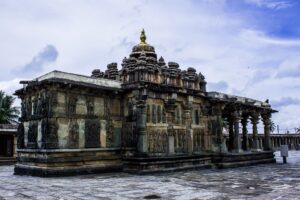 Belur is a small temple town located on the banks of Yagachi River in Hassan district. Belur is located at a distance of 38 Km from Hassan and 238 Km from Bangalore. Belur was once the capital of Hoysala empire. The main attraction of Belur is Chennakeshava Temple complex built by king Vishnuvardhana in 1117 AD in memory of his victory against Cholas in Talkad. The temple is dedicated to Lord Chennakeshava.
Belur is a small temple town located on the banks of Yagachi River in Hassan district. Belur is located at a distance of 38 Km from Hassan and 238 Km from Bangalore. Belur was once the capital of Hoysala empire. The main attraction of Belur is Chennakeshava Temple complex built by king Vishnuvardhana in 1117 AD in memory of his victory against Cholas in Talkad. The temple is dedicated to Lord Chennakeshava.
Highly polished and intricate carvings even in the dark and no two pillars are alike. The Narasimha Pillar, it seems, was built to rotate on its base. The Mohini Pillar is the most beautiful among the This star-shaped temple is believed to have taken around 103 years to build. At the entrance facing the temple is a towering Gopura and a magnificent sculpture of Garuda, Lord Vishnu’s carrier, palms touching in pious homage. The temple stands on a platform and has exquisite artwork on its outer walls adorned with bracket figures depicting the Puranas and Epics, all carved to perfection.
The lower frieze has a series of charging elephants and horses; the elephants symbolize courage while the horses are for speed. It is also believed that Shantaladevi, the queen of King Vishnuvardhana is the model for one of the sculptures – Darpana Sundari (lady with the mirror). Just outside is an interesting piece of sculpture, called the Gravity pillar which is carved out of a single rock and stands in its own weight. People can actually swipe a piece of paper across it. Equally impressive are the temples of Kappe Chennigaraya, Soumyanayaki, Andal and other Vaishnava manifestations, which surround the main temple.
And if you thought that, this is supreme stone carving skills, then just step inside. The craftmanship inside is much finer than outside. The sanctum has a magnificent 3.7 m tall image of Lord Vijaya Narayana in black stone. The prabhavali of this idol has the 10 avatars of Lord Vishnu, wrought very perfectly. The doorway with the dwarapalakas is very elegantly carved. The Garbhagriha is stellar in shape and its zigzag walls make the figures of 24 forms of Lord Vishnu look different at different times of the day due to light and shade effect.
The bracket figures of madanikas (celestial nymps) are elaborately done with even water drops chiseled to perfection. There are 4 bracket figures on the ceiling which is believed to be inspired by queen Shantaladevi’s beauty. One can see the lathe turned pillars pillars. A unique aspect in this is the artist has left a small space blank – it is believed that it is a challenge to others to do a better carving and to convey that art never dies as it is infinite.
It is open daily from 7.30 AM till 7.30 PM.
Visit: Beluru is 220 kms from Bengaluru and 155 kms. Beluru and surrounding areas are best explored in a taxi/own vehicle.
Stay: KSTDC runs the hotel Mayura Velapuri, 500 meters from Beluru Chennakeshava Temple complex. Hasana city, 40 kms from Beluru has more stay options.
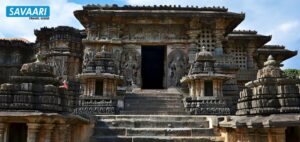 Halebeedu (formerly known as Dwarasamudra) was the ancient capital of the Hoysalas just 17 km away from Belur. The Hoysala dynasty ruled over much of South India for close to 200 years and during this time they built spectacular temples; both Hindu as well as Jain. In the 14th century, the armies of Alauddin Khilji and Muhammad Tughlak defeated the Hoysalas and raided their empire. It is recorded that enormous wealth and riches were looted. The city never recovered and fell into neglect. In fact, Halebeedu means “old house/ old ruins“. However, few temples survived this devastation like the ones in Halebeedu and today when you see them, you will be mesmerised by some the most stupendous expressions ever sculpted in stone.
Halebeedu (formerly known as Dwarasamudra) was the ancient capital of the Hoysalas just 17 km away from Belur. The Hoysala dynasty ruled over much of South India for close to 200 years and during this time they built spectacular temples; both Hindu as well as Jain. In the 14th century, the armies of Alauddin Khilji and Muhammad Tughlak defeated the Hoysalas and raided their empire. It is recorded that enormous wealth and riches were looted. The city never recovered and fell into neglect. In fact, Halebeedu means “old house/ old ruins“. However, few temples survived this devastation like the ones in Halebeedu and today when you see them, you will be mesmerised by some the most stupendous expressions ever sculpted in stone.
The Hoysaleswara Temple poised on a star-shaped base on the lawn is an architectural marvel. This twin-shrined temple is perhaps the largest Shiva temple built by the Hoysalas. Its base consists of 8 rows of friezes carved with elephants, lions, horses and floral scrolls. Its walls are adorned with intricately carved Hindu deities, sages, stylised animals, birds and friezes depicting the life of Hoysala kings. Imagery from epics like the Ramayana, Mahabharatha and Bhagavad Gita adorn the outer walls with highly ornate temple doorways. It is believed that no other temple in the country captures the Indian epics as elegantly as Hoysaleswara Temple. The Nandimantapa is positioned right in front of the temple wherein there is a huge Nandi richly decorated with stone ornaments. Behind this is a shrine dedicated to Surya with a 2 m tall image. There are exquisite carvings in the interiors of the temple as well. The most striking item is the highly polished lathe-turned pillars.
Other temples: Apart from Hoysaleshwara Temple, Halebeedu is also known for Kedareshwara Temple and multiple Jain temples. Kedareshwara Temple was built by King Veera Ballala the second and Queen Ketaladevi.
Museum: An archaeological museum maintained by ASI inside Halebeedu Temple complex houses over 1500 sculptures and artefacts of the Hoysala era.
Visiting Hours: Halebeedu Temple complex is open from 6.30 AM till 9 PM.
Places to visit nearby: Beluru Chennakeshava Temple is often visited along with Halebeedu (17 kms away).
How to reach Halebeedu: Halebeedu is 210 kms from Bengaluru and 170 kms from Mangaluru. Banavara is the nearest railway station (30 kms). Halebeedu has good bus service from district head quarter Hasana (33 kms)
Places to stay near Halebeedu: KSTDC runs Hotel Mayura Shantala in Halebeedu right across the temple complex. More options are available Hasana city (33 kms away).
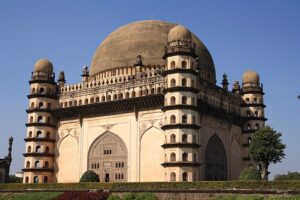 This grand mausoleum is the final resting place of Mohammed Adil Shah, who was the ruler of Bijapur during the 17th century. The construction of the structure dates back to 1626 when the Sultan had just ascended the throne. It was his idea to build an impressive mausoleum for himself. Ironically, the structure was completed in 1656 after he breathed his last.
This grand mausoleum is the final resting place of Mohammed Adil Shah, who was the ruler of Bijapur during the 17th century. The construction of the structure dates back to 1626 when the Sultan had just ascended the throne. It was his idea to build an impressive mausoleum for himself. Ironically, the structure was completed in 1656 after he breathed his last.
The name Gol Gumbaz has been derived from the words Gol Gumbadh or Gol Gummata, which means a dome in the circular shape. Since the most prominent feature of the structure is its giant circular dome, it came to be known as such. Apart from the Sultan’s mortal remains, the mausoleum houses the crypts of his two wives namely Taj Jahan Begum, Aroos Bibi, grandson, daughter, and his mistress Rambha.
Gol Gumbaz Architecture
Gol Gumbaz counts among the finest examples of Deccan Indo-Islamic architectural style. The colossal structure is made out of dark grey basalt. It reaches up to 51 meters in height while the giant dome has an external diameter of 44 meters, making it one of the largest domes ever built. Four dome-capped towers adorn the edifice on four sides. Each of these towers is seven stories high and has a staircase built inside it. A square podium with an intricately carved wooden canopy exists inside the main mausoleum hall. The cenotaph slab in the middle of the podium marks the location of the actual tomb of the Sultan, in the ground below.
The mausoleum hall boasts of an area 18000 sq. ft., which marks it as one of the world’s largest single-chamber spaces. An interesting feature of Gol Gumbaz is that a whispering gallery runs around the dome’s inner periphery. Any sound made here gets echoed at least seven times or more. When you are inside the whispering gallery, you can hear even the softest of sounds from the other side of the monument. This phenomenon is attributed to the impressive acoustics of the structure.
Another impressive aspect of this structure is that there are no towers or pillars that provide support to the huge dome, which is an architectural marvel in itself. The dome, on the other hand, is held by eight intersecting arches from the inside.
Gol Gumbaz
Today, Gol Gumbaz stands as one of the most significant heritage monuments in India maintained by the Archeological Survey of India. It attracts a steady stream of visitors from far and near due to its spellbinding architecture and unique acoustic features. There is a museum situated near the structure that showcases an interesting collection of paintings, Chinese parchments, carpets, and other artifacts.
Things to See in the Gol Gumbaz Complex
Gol Gumbaz is located in a sprawling green compound that houses a few other attractions as well. These include the following:
• A mosque
• A Dharamshala or tavern
• Nakkar Khana or drum house
• A museum
• A well-maintained garden
Lesser Known Facts about Gol Gumbaz
• It is believed that the dome of Gol Gumbaz is the second largest in the whole world, the largest one being the dome of St. Peter’s Basilica in Rome.
• Mohammed Adil Shah built this huge structure during his reign because he wanted his tomb to be better than the tomb of his father, Ibrahim Rauza.
• This monument is sometimes referred to as the Taj Mahal of South India.
• When you enter the structure, you can see a stone hanging over its main entrance. Also called ‘bijli pathar’, it is in fact a piece of meteorite that fell onto the earth during the Sultan’s reign. It is believed that this stone protects the mausoleum from lightning.
• There is a train named after the structure – the Gol Gumbaz Express – that operates between Mysore and Solapur. The train passes via Bijapur.
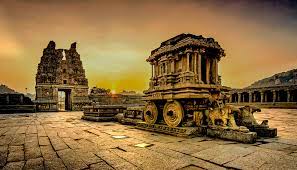 Tungabhadra river in the Vijayanagara district of Karnataka. It is a sheer delight for travellers, who have an eye for history and religion. The ancient ruins of the historic village of Hampi, which spreads over 4,100 hectares, are remnants of the glorious past and still strike wonder in people who visit the place.
Tungabhadra river in the Vijayanagara district of Karnataka. It is a sheer delight for travellers, who have an eye for history and religion. The ancient ruins of the historic village of Hampi, which spreads over 4,100 hectares, are remnants of the glorious past and still strike wonder in people who visit the place.
Distance: 342 Km
Location:Hampi
The History of Hampi
Hampi was a fortified city and the capital of the Vijayanagara empire in the 14th century. Hampi in 1500 CE had the glory of being the world’s second largest city after Beijing. It was a flourishing city, drawing traders from Persia and Portugal. It has been recorded in the chronicles by the Persian, European travellers, particularly the Portuguese that Hampi on the banks of the Tungabhadra river in those days spelt prosperity with many temples, farms and trade markets.
The monuments of the Vijayanagara city were constructed between 1336-1570 AD from the times of Harihara-I to Sadasiva Raya. Krishnadevaraya also contributed in the way of royal buildings from 1509 to 30 AD. The structures boast of Dravidian architecture. However, in 1565, the muslim sultanates conquered Hampi and brought its ruin. Though the place is pillaged and is in ruins, the beautiful natural setting of Hampi, which comprises the River Tungabhadra and the boulders are present to this day.
Stone Chariot at Vittala Temple, Hampi
Hampi today – Places to visit in Hampi
Hampi is an archeological wonder and famous for its beautiful monuments, though in ruins that are remnants of the glorious past. UNESCO describes Hampi as an “austere, grandiose site” boasting of “forts, riverside features, royal and sacred complexes, temples, shrines, pillared halls, mandapas, memorial structures, water structures, stables etc. Large dimensions, florid ornamentation, bold and delicate carvings, stately pillars, magnificent pavilions are characteristics of the temples of Hampi, depicting scenes from the Ramayana and the Mahabharata.
• Of these, the Krishna temple complex, Narasimha, Ganesa, Hemakuta group of temples, Achyutaraya temple complex, Vitthala temple complex, Pattabhirama temple complex, Lotus Mahal complex etc are worth the mention.
• The Virupaksha temple, also referred to as the Pampapathi temple is beautifully renovated, maintaining its old charm and is now in worship. It is the oldest shrine and the most important destination for tourists and pilgrims.
• The Vittala temple is a splendid depiction of the Vijayanagara style of architecture.
• Hazara Ramachandra temple, Chandrasekhara temple, the Krishna temple, Pattabhirama temple, Jaina temples are also other examples of beauty and grace.
• The Queen’s palace and the Lotus-Mahal within the Zenana enclosure depict the magnificent anthapura.
• The Dhananayaka’s enclosure (treasury), Mahanavami Dibba, the elephant’s stables, pillared mandapas and numerous ponds and lakes still speak of the erstwhile glory of Hampi.
• There has also been recent excavations of palatial complexes, a large number of stone images, beautiful terracotta objects, stucco figures, a square stepped-tank (Sarovara) at the south-west of Mahanavami Dibba, Buddhist sculptures of 2nd -3rd century AD etc.
• The Archaeological museum is a home to antiques and great sculptures.
• The underground Shiva temple is one of the oldest temples in Hampi, dedicated to Lord Shiva. Most parts of this temple remain submerged in water because it was built several meters below the ground level.
• The Yantrodharaka Hanuman temple, also called the Monkey temple, believed to be the birthplace of Lord Hanuman situated on a hillock, is also worth the visit in Hampi.
• Bellary, Anegundi and Kamalapur near Hampi have historical value and attract a lot of tourists.
Best time to visit Hampi
The best time to visit Hampi is from October to February during Winter, favourable for exploring the place except in the warm afternoons. The monsoon season from July to September is also an ideal time to visit Hampi with less rain, yet rendering a vibrant green look to its surroundings. Summer from March to June is generally very hot and is not the ideal time to visit Hampi.
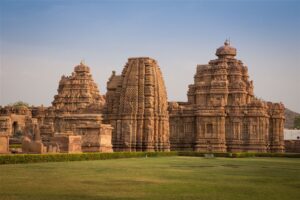 The Pattadakal monuments are located in the Indian state of Karnataka,. In total, there are over 150 Hindu, Jain and Buddhist monuments, and archaeological discoveries, dating from the 4th to 10th century CE, in addition to pre-historic dolmens and cave paintings that are preserved at the Pattadakal-Badami-Aihole site. The tiny village of Pattadakal is situated on the banks of the Malaprabha river. Referred to as Petrigal by Ptolemy, Pattadakal was later known variously as Raktapura (Red Town) & Pattadakal Kisuvolal . This place reached its pinnacle of glory under the Chalukyas from the seventh to the ninth centuries functioning as a royal commemorative site. The group of about ten temples, surrounded by numerous minor shrines & plinths, represents the climax of early Western Chalukyan Architecture. King Vikramaditya II (734 – 745 AD) and his art loving queens Lokmahadevi & Trailkyamahadevi, brought sculptors from Kanchipuram to create fantasies in stone in Pattadakal.
The Pattadakal monuments are located in the Indian state of Karnataka,. In total, there are over 150 Hindu, Jain and Buddhist monuments, and archaeological discoveries, dating from the 4th to 10th century CE, in addition to pre-historic dolmens and cave paintings that are preserved at the Pattadakal-Badami-Aihole site. The tiny village of Pattadakal is situated on the banks of the Malaprabha river. Referred to as Petrigal by Ptolemy, Pattadakal was later known variously as Raktapura (Red Town) & Pattadakal Kisuvolal . This place reached its pinnacle of glory under the Chalukyas from the seventh to the ninth centuries functioning as a royal commemorative site. The group of about ten temples, surrounded by numerous minor shrines & plinths, represents the climax of early Western Chalukyan Architecture. King Vikramaditya II (734 – 745 AD) and his art loving queens Lokmahadevi & Trailkyamahadevi, brought sculptors from Kanchipuram to create fantasies in stone in Pattadakal.
Distance: 442 KM From Banglore
Jambulinga Temple
Another small temple with a fine figure of the Dancing Shiva with Nandi & Parvathi by his side. Built with a northern style tower, there is a horse-shoe arched projection on its facade.
Virupaksha Temple
The Mallikarjuna & the Virupaksha temples were built by two queens of Vikaramaditya II to commemorate the victory of the Chalukyas over the Pallavas. As the Virupaksha temple was built by Queen Lokamahadevi, it was originally called Lokeshwara. The temple is rich in sculpture like those of Lingodbhava, Nataraja, Ravananugraha & Ugranarasimha. Built in the southern Dravida style, it is the largest temple in the enclosure. Jain Temple Half a Kilometer from the enclosure, on the Pattadakal-Badami Road, is this Jain temple built in the Dravidian style. It has some very beautiful sculpture & probably dates from the ninth century.
Galaganath Temple
Built of sandstone, the tower is in the northern “Rekhanagara” style. The temple was probably never completed. It contains a beautiful sculpture of Shiva in the act of killing the Andhakasura.
Sanghameswara Temple
Perhaps the oldest temple in Pattadakal, it was built by King Vijayaditya ( 696-733 AD) & was called Vijayewara after him. Now called Sangameshwara, the temple is built in Dravidian style & consists of a sanctum, inner passage & a hall. There are sculptures on the outer wall like those of Ugranarasimha & Nataraja.
Kada Siddeshwara Temple
This small temple, built in the North Indian style, consists of shrine & a hall. There is a fine sculpture which depicts Shiva holding a serpent & trident in his raised arms with Parvathi by his side.
Malikarjuna Temple
Built by Trailokyamahadevi, the queen of Vikramaditya II (734-745AD), it was originally called Trailokeshwara Temple. It is similar to the Virupaksha Temple but smaller in size. The ceiling has panels of Gajalakshmi & Nataraja with Parvathi. Pillars in the temple depict the birth & life of Krishna. There are sculptures of Mahishasuramardini (very similar to the one in Mamallapuram) & Ugranarasimha.
Papanatha Temple Just outside the enclosure is this ornate temple built about 680 AD. This was an early attempt to develop the northern style of architecture, which was later abandoned in favour of the more balanced Dravidian or Pallava style. It contains impressive sculpted scenes from Ramayana & Mahabharatha.
Sculpture Gallery There is a sculpture gallery maintained by Archeological survey of India within the Pattadakal temple complex.
Cultural Importance and Specialities
o Banashankari Temple Festival is held near Badami during January-February each year.
o Virupaksha Temple Car Festival in Pattadakal in March.
o Mallikarjuna Temple Festival in Pattadakal in March-April.
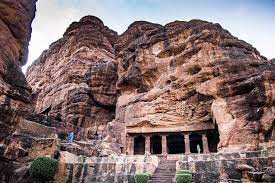 The Badami cave temples are located in the town of Badami in the north-central part of Karnataka, India.
The Badami cave temples are located in the town of Badami in the north-central part of Karnataka, India.
Distance: 463 km From Banglore
Badami, the one time capital of the Chalukyas , is noted several temples, some structural & other rock-cut, of the 6th & 7th Centuries. The foundations of Badami, or Vatapi as it was called, were laid by Pulakeshi I (535 – 566 AD) his son Kirtivarman, the Ist (567 – 598 AD), beautified the town with temples & other buildings
Mangalesha (598 – 610 AD) brother of Kiritavarman I completed the construction of the cave temples & endowed the temples with the village on the occasion of the installation of the image of Vishnu. The greatest ruler of the dynasty was Pulakeshi II (610-642 AD) who among others defeated the Pallava King Mahendra Verman I. The Pallava later captured & destroyed Badami to avenge their defeat Badami was also in the possession of the Vijayanagar Kings, The Adil Shahis, The Savanur Nawabs, The Marathas, Hyder Ali & finally the British who made it part of the Bombay Presidency.
Badami Caves
1 km, this group of 4 cave temples have been carved out of the hill opposite Badami fort. The Chalukyan king, Mangalesa(598-610)AD)was responsible for the completion of these cave temples. Of the four, three are Brahmanical, while the fourth is Jain. Nearly 2000 steps have to be climbed to reach the cave.
Cave I
This is Shaivite cave. The important carvings in this cave are an 18-armed dancing Shiva, a two-handed Ganesha, Mahishasura Mardini, Ardha Nareeshwara & Shankarnarayana. The ceiling is adorned by a serpent motif & other carved figures.
Cave II
This cave has Vaishnavite influence with panels of Trivikrama & Bhuvaraha. On the ceilings are carvings of Anantasayana, Brahma, Vishnu, Shiva &other Ashtadikpalas
Cave III
Another flight of steps takes one to the third cave which is the largest & the best of the lot. This cave has carvings pertaining to both Shaivite & Vaishnavite themes. Panels of Trivikrama, Narasimha, Shankaranarayana, Bhuvaraha, Anantasayana & Harihara are engraved in a vigorous style. An inscription found here records the creation of the shrine by Mangalesha in 578 AD. There are some fine bracket figures on the pillars of this cave
Cave IV
Lying to the east of cave three, the fourth cave is Jain. There is an image of Mahavira adorning the sanctum. Other carvings here are of Padmavathi & other Thirthankaras. Asteep climb up some steps cut in a crevice between Cave II & III leads to the southern part of Badami Fort & to an old gun placed there by Tippu Sultan.
Badami Fort
2 Kms. Strategically situated on top of the hill, the fort encloses large granaries, a treasury impressive temples on top of the northern end of the hill. Malegitti Shivalaya, perhaps the oldest temple of the lot, is dedicated to the benign aspect of Shiva as the garland maker. Placed on the summit of a rocky hill, the temple is built of stone, finely joined without mortar, & with Dravidian tower. The lower Shivalaya has a Dravidian tower of which only the sanctum remains now.
There are some more temples in Badami town & several of them dotting the banks of a well-built tank locally called the Agasthya Tirtha.
Food Specialities
No specialty restaurants are available at Aihole. Moderate Indian Style Restaurants are available in Badami Town. Chinese & Continental Food can be served by the Hotel Mayura Chalukya on advance notice.
Cultural Importance of the Town
o Banashankari Temple Festival near Badami during January- February.
o Virupaksha temple Car Festival in Pattadakal in March.
o Mallikarjuna Temple Festival in Pattadakal in March-April.
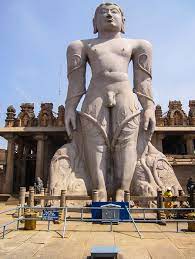 shravanabelagola is an important Jain pilgrimage Centre in South Karnataka. Shravanabelagola is home to the 18 m high statue of Lord Gometeshwara; considered to be one of the world’s tallest free-standing monolithic statues. Constructed in 981 AD by Chamundaraya, a Ganga warrior, it is carved out of a single block of granite and looms on the top of Vindhyagiri Hill. It is visible up to 30 km away. There are nearly 700 steps hewn in the rock-face which must be climbed to have a close-up view of this colossal magic. It is amazing to see so much grace and poise etched on a sculpture of such big scale. The statue truly reflects the idea of great strength devoid of rage and anger. This massive monolithic statue of Lord Gomateshwara will definitely leave you in awe. The surrounding enclosures has images of all the Jain Tirthankaras.
shravanabelagola is an important Jain pilgrimage Centre in South Karnataka. Shravanabelagola is home to the 18 m high statue of Lord Gometeshwara; considered to be one of the world’s tallest free-standing monolithic statues. Constructed in 981 AD by Chamundaraya, a Ganga warrior, it is carved out of a single block of granite and looms on the top of Vindhyagiri Hill. It is visible up to 30 km away. There are nearly 700 steps hewn in the rock-face which must be climbed to have a close-up view of this colossal magic. It is amazing to see so much grace and poise etched on a sculpture of such big scale. The statue truly reflects the idea of great strength devoid of rage and anger. This massive monolithic statue of Lord Gomateshwara will definitely leave you in awe. The surrounding enclosures has images of all the Jain Tirthankaras.
Distance:145 Km from Banglore
Location:Shravanabelagola
Vindhyagiri: Vindhyagiri is a large rocky hill 133 meters above ground (1002 meters above sea level). The Gomateshwara statue is located at the top of Vidhyagiri hill, surrounded by a temple complex. Reaching the top requires climbing hundreds of steps cut on the rock. Palanquin service is available to carry senior citizens wishing to visit the temples and statue on Vindhyagiri
Chandragiri Hill: Chandragiri hill is located opposite to Vindhyagiri. 14 different temples (Jain Basadi) are found on top of Chandragiri, most prominent ones being Shantinatha, Parshvanatha and Chandragupta basadi.
Timings: Shravanabelagola temple timings are 6.30 AM to 11.30 AM and 3.30 PM to 6.30 PM. At least half a day is recommended to explore the hills of Shravanabelagola.
Mahamasthakabhisheka: Perhaps the most thrilling act of worship can be witnessed here during the renowned Mahamasthakabhisheka ceremony. Every 12 years, Jain pilgrims gather here to participate in the colourful Mahamasthakabhisheka of the Lord (head-anointing ceremony). From a specially erected scaffolding, priests and devotees pour hundreds of pots of curd, milk, honey, vermilion, coconut water, turmeric paste, and even gold and precious jewels over the statue’s head. The whole structure is awash in different colours which is a sight worth seeing. The most recent Maha Mastakabhisheka was held in 2018.
Places to visit near Shravanabelagola: Shettihalli Church (72kms), Markonahalli dam (62 km), Sakaleshapura (92 km), Melukote (35 km), KRS Dam (60 km), Beluru and Halebidu (90 kms) are some of the attractions which can be visited along with a tour of Shravanabelagola.
How to reach Shravanabelagola: Shravanabelagola is 145 km from Bengaluru.
Places to stay near Shravanabelagola: Being an important Jain Pilgrimage Centre, the temple management runs two Dharamshalas or guest houses which can be booked subject to availability by visiting temple offices. Budget hotels are available in Shravanabelagola town. More stay options are available at Chennarayapattana town 12 km from Shravanabelagola.
